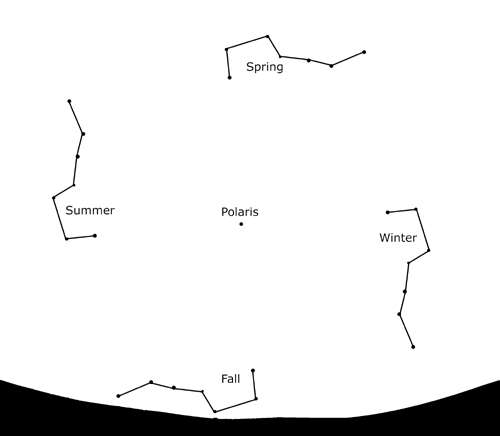
Tonight, at mid-northern latitudes, look for the brilliant star Arcturus to climb over your eastern horizon around 9 to 10 p.m. local time. That’s the approximate time on your clock, regardless of your longitude. South of the equator, this northerly star rises considerably later in the evening. Click here to know when Arcturus rises into your sky.
Extend the natural arc of the Big Dipper handle to verify that you’ve found Arcturus. The Big Dipper can actually be seen from as far south as the tropical and subtropical regions of the Southern Hemisphere. However, the Big Dipper doesn’t reach its high point for the night in late February until an hour or two after the midnight hour.
Use Big Dipper to find Polaris, the North Star

If you’re in the northern U.S., Canada or at a similar latitude, the Big Dipper is circumpolar for you – always above the horizon. These images show the Dipper’s location at around midnight in these seasons. Just remember “spring up and fall down” for the Dipper’s appearance in our northern sky. It ascends in the northeast on spring evenings, and descends in the northwest on fall evenings. Image via burro.astr.cwru.edu
In the Northern Hemisphere, Arcturus counts as our faithful springtime star. At present, Arcturus rises about three hours after sunset at mid-northern latitudes. Yet this shining beauty of a star rises about 4 minutes earlier each day whereas the sun sets a bit later daily. All added up, that means Arcturus will be sparkling above the horizon at dusk/nightfall in late March to announce the return of spring to the Northern Hemisphere!
Bottom line: Before going to bed tonight, locate the Big Dipper in your northern sky, and then follow the arc in the Dipper’s handle to find yellow-orange star Arcturus.
from EarthSky http://ift.tt/1n0V4Ks

Tonight, at mid-northern latitudes, look for the brilliant star Arcturus to climb over your eastern horizon around 9 to 10 p.m. local time. That’s the approximate time on your clock, regardless of your longitude. South of the equator, this northerly star rises considerably later in the evening. Click here to know when Arcturus rises into your sky.
Extend the natural arc of the Big Dipper handle to verify that you’ve found Arcturus. The Big Dipper can actually be seen from as far south as the tropical and subtropical regions of the Southern Hemisphere. However, the Big Dipper doesn’t reach its high point for the night in late February until an hour or two after the midnight hour.
Use Big Dipper to find Polaris, the North Star

If you’re in the northern U.S., Canada or at a similar latitude, the Big Dipper is circumpolar for you – always above the horizon. These images show the Dipper’s location at around midnight in these seasons. Just remember “spring up and fall down” for the Dipper’s appearance in our northern sky. It ascends in the northeast on spring evenings, and descends in the northwest on fall evenings. Image via burro.astr.cwru.edu
In the Northern Hemisphere, Arcturus counts as our faithful springtime star. At present, Arcturus rises about three hours after sunset at mid-northern latitudes. Yet this shining beauty of a star rises about 4 minutes earlier each day whereas the sun sets a bit later daily. All added up, that means Arcturus will be sparkling above the horizon at dusk/nightfall in late March to announce the return of spring to the Northern Hemisphere!
Bottom line: Before going to bed tonight, locate the Big Dipper in your northern sky, and then follow the arc in the Dipper’s handle to find yellow-orange star Arcturus.
from EarthSky http://ift.tt/1n0V4Ks

Aucun commentaire:
Enregistrer un commentaire